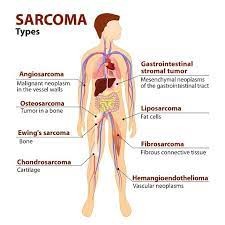Sarcoma - Symptoms, Types, Causes and Treatments

Sarcoma
Sarcoma is a type of cancer that starts in the cells of
connective tissue, such as fat, muscle, and bone. Sarcomas include tissues such
as:
·
Bone and joint
·
Breast
·
Female genitalia
·
Lungs and pleura (the lining of the lungs)
·
Thighs and legs
The word sarcoma may refer to any tumor with these
features. Some sarcomas are benign (non-cancerous) such as liposarcoma (fat
tissue).
Others types are malignant, which means they can grow
rapidly and invade nearby tissue. This can make it more difficult for the body
to fight cancer.
Unlike most cancers, any type of sarcoma can occur in
men or women. Sarcomas affect all age groups and ethnic groups all over the
world, and this is even in countries with low rates of other cancers.
This may be because people in these areas get less
screening, such as mammograms for breast cancer, and do not notice symptoms
until the disease has spread to other organs. In developed countries, sarcomas
are most common among middle-aged adults between 35 and 55 years old.
The symptoms of a sarcoma depend on where the tumor is
growing. In some cases, a person can have a sarcoma and have no symptoms.
In other cases, the tumor may be painful or it may
press on an important organ, such as the lungs or the stomach.
Some tumors of the bone break through the skin allowing
a bump to be felt. Some tumors of soft tissues, such as fat or muscle, can
cause swelling in the area of the tumor.
If a person has a recently developed new growth on any
part of their body, what they see in their mirror or feel when they touch it is
an important clue that needs to be shared with both their primary care
physician and dermatologist.
A physical exam is also helpful to determine if further
investigation is needed.
Sarcomas can also be a symptom of a chronic illness.
People who have a known, suspected or unknown underlying condition may have
sarcoma as a symptom of their condition.
In this case, the primary care physician should
initiate testing for the underlying condition. If the patient's symptoms do not
improve with the treatment of their primary condition, they should be referred
to a specialist who can evaluate them for sarcoma and/or other cancers.
If sarcoma is diagnosed, treatment is often recommended
at the same time as the other cancer tests.
While many patients will respond well to standard
chemotherapy and radiation treatments, others will not respond and require more
aggressive treatment (such as surgery).
A patient who is diagnosed with sarcoma should be
referred to a medical center specializing in the treatment of sarcoma. Some
hospitals are equipped specifically to treat certain types of sarcomas. This
specialized treatment is known to offer the best chance for survival.
Most centers involve the expertise of multiple specialists,
including surgeons, radiation oncologists, medical oncologists, and clinical
geneticists, all under one roof.
The standard treatment for sarcomas are rarely curative
but can prolong life. Often, chemotherapy is used first to help shrink the tumor.
If this doesn't work, radiation therapy may be used.
The goal of radiation therapy is to kill off any cancer
cells that might be growing in the surrounding tissues or organs, thereby
preventing them from spreading. Radiation therapy is not curative, but it can
have a major impact on tumor growth and improve survival chances.
Surgery is very important in sarcoma treatment because
it can provide access for better treatments or if doctors need access to the
circulatory system of the patient.
Frequently Asked Questions On Sarcoma
What Are Some Things I Can Do To Learn More About Sarcoma?
The Sarcoma Alliance of America is a patient-based
organization that provides education and emotional support to people affected
by sarcoma in the United States.
Their website has valuable information including, but
not limited to, an interactive section on sarcomas. There is also an online
community with message boards, blogs, and forums for people affected by
sarcomas.
The Sarcoma Research Foundation is dedicated to funding medical research to find a cure for sarcomas. They provide funding to Lawrence Berkeley National Laboratory to create, implement and manage new treatment protocols.
